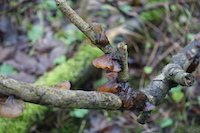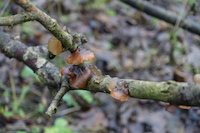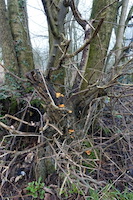Jelly fungi
13/01/16 19:45
Came across this fine jelly fungus whilst out on the New Year Plant hunt. It was attached to an old ash in the Paddock.


Jelly fungi have a fruiting body with a gelatinous surround to the hyphae. This expands when wet and drys out to a thin layer which may be virtually transparent and easy to miss. With the amount of rain we have had here recently they were pretty expanded. They are all heterobasidiomycota, i.e. with septate basidia (spore-producing structure on the fruiting body of the fungus), in contrast to the majority of mushrooms for example. Apparently they can also generate self-replicating spores without having to pass via a hyphae stage. Classification seems to be both complex and changeable.
Apparently jelly fungi are paraphyletic, i.e. the group contains the group's last common ancestor and all that ancestor's descendants with the exception of a small number of that group's monoleptic groups. Very few family reconstruction studies could claim that.
I haven't attempted formal identification. It may be Orange Jelly (Dacrymyces palmatus). Or it may not. If it is, it is apparently edible but I don't think I'll bother…
The velvet shank is out also, and something has been stripping the bark off it's supporting coppiced lime.



Jelly fungi have a fruiting body with a gelatinous surround to the hyphae. This expands when wet and drys out to a thin layer which may be virtually transparent and easy to miss. With the amount of rain we have had here recently they were pretty expanded. They are all heterobasidiomycota, i.e. with septate basidia (spore-producing structure on the fruiting body of the fungus), in contrast to the majority of mushrooms for example. Apparently they can also generate self-replicating spores without having to pass via a hyphae stage. Classification seems to be both complex and changeable.
Apparently jelly fungi are paraphyletic, i.e. the group contains the group's last common ancestor and all that ancestor's descendants with the exception of a small number of that group's monoleptic groups. Very few family reconstruction studies could claim that.
I haven't attempted formal identification. It may be Orange Jelly (Dacrymyces palmatus). Or it may not. If it is, it is apparently edible but I don't think I'll bother…
The velvet shank is out also, and something has been stripping the bark off it's supporting coppiced lime.





